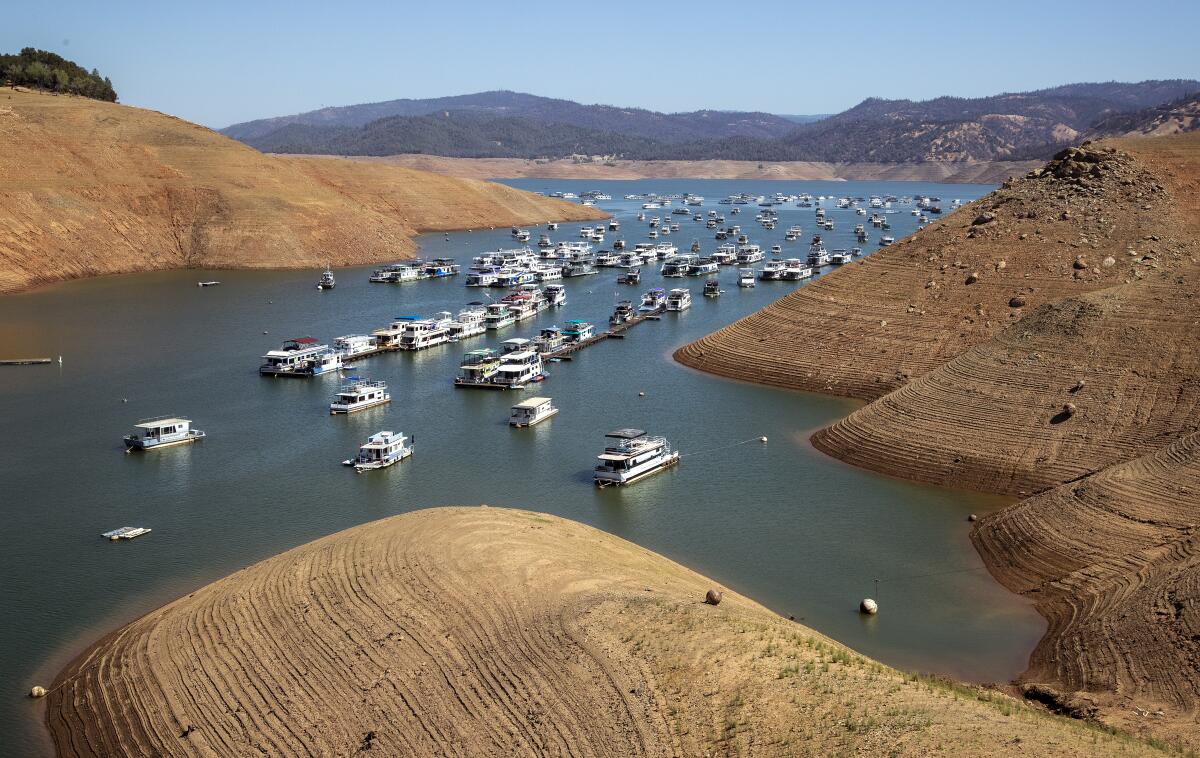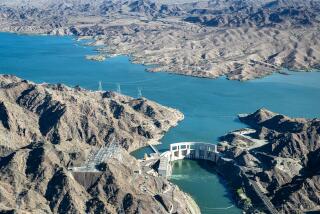With no respite from drought, officials call upon Californians to conserve water

- Share via
The start of this year has been the driest in California’s history. With the severe drought now in a third year, the state faces depleted reservoirs, a meager snowpack in the Sierra Nevada and a worsening water shortage on the Colorado River.
Under sunny blue skies in Sacramento, where it hasn’t rained in two months, officials stood Thursday in front of a mulch-covered garden and appealed for Californians to save water.
“We’re asking all Californians to step up,” said Wade Crowfoot, secretary of the California Natural Resources Agency. That means reducing water usage immediately and also taking steps that will help conserve in the long run, he said, such as replacing grass with drought-tolerant plants, or switching to water-saving appliances.
“Our drought conditions are becoming more threatening with climate change,” Crowfoot said. Warmer winters are reducing the snowpack that accumulates in the Sierra Nevada, he said, and hotter temperatures in the spring and summer “mean that more of that snow absorbs into very dry soils or evaporates into the air.”
In July, Gov. Gavin Newsom called for Californians to voluntarily reduce water use by 15%. Most areas of the state have fallen far short of that target.
The latest conservation figures for cities and towns across the state through December showed cumulative water savings of 7.5% compared with a year ago, and that’s “not going to be enough” in many communities, said Joaquin Esquivel, chair of the State Water Resources Control Board.
The levels of many major reservoirs in California, from Lake Oroville to the San Luis Reservoir, remain far below average. The snowpack in the Sierra Nevada, which feeds the state’s reservoirs, now stands at just 60% of average for this time of year.
Large water suppliers throughout the state have responded with drought measures including advertising campaigns that encourage conservation.
The state’s Save Our Water campaign, together with the State Water Contractors, released an animated video to spread the message. With the handwritten slogan “Doing your part” on a whiteboard, the video shares water-saving tips, such as installing drip irrigation systems, using a smart irrigation controller and taking five-minute showers.
The Metropolitan Water District of Southern California has announced it is spending an additional $10.5 million to expand its advertising campaign calling for the public to conserve.
“Our reservoirs continue to decline, and so we are really in a critical time to move on our efforts to fortify our water supply,” Adel Hagekhalil, MWD’s general manager, told the district’s board this week.
In announcing the expanded advertising campaign, Hagekhalil said the less water Southern California uses now, “the longer we can stretch these stored supplies into the summer and fall, and next year, if needed.”
During the last drought, which lasted from 2012 to 2016, the state imposed mandatory conservation measures and required local agencies to meet water-saving targets. The conservation gains made then have had a lasting effect in reducing residential water use.
State officials haven’t yet turned to mandatory restrictions during the current drought, which began in 2020. They have instead focused so far on strengthening requirements for local water agencies to create more comprehensive contingency plans for water shortages.
“Right now, we’re working with our local water agencies and really being very clear about our expectation that they’re stepping up and they’re taking action through those water shortage contingency plans, which may involve mandatory restrictions on a local or regional basis,” Crowfoot said.
Heather Cooley, a water researcher at the Pacific Institute, said she thinks California needs to strengthen its response and shift to mandatory restrictions.
“Given how severe the drought is and how low our reservoirs are, and the low snowpack, I’m not sure 15% is enough. We’re going to have to do more,” Cooley said.
Cooley said the last drought showed that conservation mandates work. California has over the last several years developed better data on water use and efficiency, she said, which can be used to create more customized mandates that reflect the local drought conditions as well as past progress on conservation.
Southern California relies on imported water from the Sacramento-San Joaquin River Delta and the Colorado River, both of which have been severely affected by the drought.
The Colorado River supplies water for approximately 40 million people and vast farmlands from Wyoming to Mexico. The river has long been overallocated, and the levels of its reservoirs have declined dramatically during the stretch of hot, dry years since 2000.
Scientists have found that the extreme dryness across the West, from Montana to northern Mexico, is now the driest 22-year period in at least 1,200 years, a megadrought that research shows is being worsened by humanity’s heating of the planet.
Water cutbacks have already taken effect for Arizona and Nevada, and officials representing California agencies recently joined those two states in an agreement to take less from the river.
The declines on the river have worsened during the dry winter. Lake Powell, one of the river’s two major reservoirs, has declined to about 25% of full capacity.
Water managers with the federal Bureau of Reclamation said this month that the reservoir on the Arizona-Utah border will soon decline below a key threshold of 3,525 feet elevation. Officials had agreed on that threshold in 2019 because if the reservoir declines to 3,490 feet, the water would reach “minimum power pool,” the lowest point at which Glen Canyon Dam can generate hydropower.
There is now a 1 in 4 chance that could happen in 2023 or 2024, according to the latest projections from the federal government.
More to Read
Sign up for Essential California
The most important California stories and recommendations in your inbox every morning.
You may occasionally receive promotional content from the Los Angeles Times.










